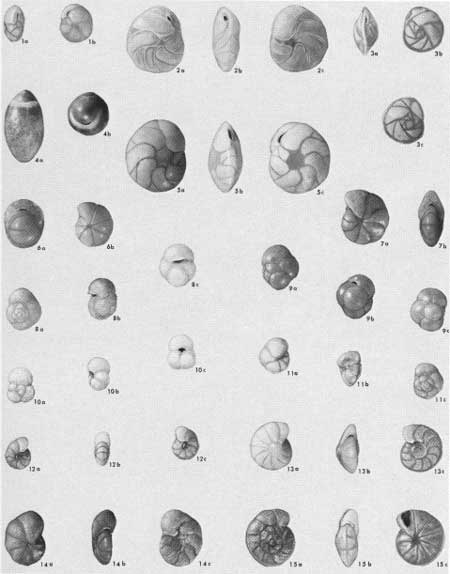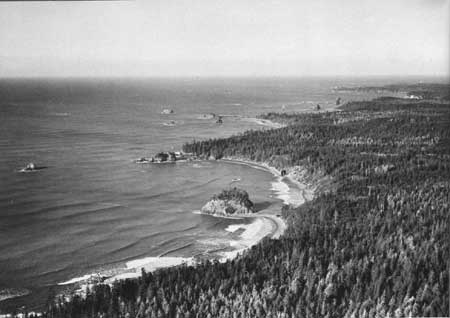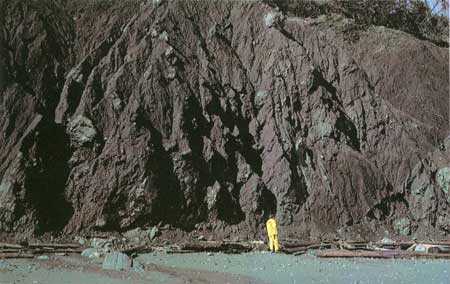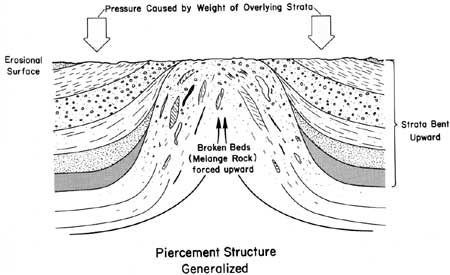
|
Washington Department of Natural Resources Geology and Earth Resources Division Bulletin No. 72 Washington Coastal Geology between the Hoh and Quillayute Rivers Weldon W. Rau |
PART I
ROCK FORMATIONS AND GEOLOGIC PROCESSES
(continued)
HOH ROCK ASSEMBLAGE
SEDIMENTARY ROCK SEQUENCES
The earth's crustal rocks, exposed between the Hoh and Quillayute Rivers, and in many places as far south as Point Grenville, are referred to as the Hoh rock assemblage (Rau, 1973, 1979). As the term assemblage implies, the Hoh rocks are not a single definable rock formation, but are a group of rocks that vary greatly in composition and in geologic age. Many are sequences of siltstones, sandstones, and conglomerates and were originally deposited as sediments in a deep sea basin. These types of Hoh rocks are referred to as SEDIMENTARY ROCK SEQUENCES. They make up most of the headland areas and offshore, low-tide reefs along the coast between the Hoh and Quillayute Rivers (fig. 6). The age of these rocks (the geologic time when their sediments were first deposited in the sea) is based on a few fossil collections from widely scattered coastal outcrops. Most of these fossils are the remains of microscopic marine organisms (fig. 7) and others are larger invertebrate marine animals, mainly clams and snails. The geologic age that the fossils represent is varied. Some fossils indicate an age as old as a late part of the Eocene Epoch (about 40 million years ago), while others suggest an age as young as a middle part of the Miocene (about 20 million years ago, fig. 1).

|
| HOH HEAD, one of the more prominent head lands along the Washington coast, is a thick bedded sequence of sandstone and is a part of the Hoh rock assemblage (Photo courtesy of the Olympic National Park Service, Port Angeles, Washington) (fig. 6). |

|
|
MICROSCOPIC FOSSILS (Foraminifera) are abundant
in sedimentary rocks of marine origin. Because they vary according to
where and when they lived, fossil Foraminifera are used in determining
time and environment of sedimentation. All specimens are magnified X 25
and are identified below: 1. Cassidulina islandica Norvang 2. Cassidulina limbata Cushman and Hughes 3. Cassidulina translucens Cushman and Hughes 4. Chilostomella cf. C. czizeki Reuss 5. Cassidulina reflexa Galloway and Wissler 6. Pullenia miocenica Kleinpell 7. Pullenia cf. P. salisburyi R. E. and K. C. Stewart 8. Globigerina pachyderma (Ehrenberg) 9. Sphaeroidina bulloides d'Orbigny 10. Globigerina bulloides d'Orbigny 11. Globorotalia crassaformis (Galloway and Wissler) 12. Anomalinoides quinaultensis Rau 13. Cibicides conoideus Galloway and Wissler 14. Cibicides fletcheri Galloway and Wissler 15. Cibicides mckannai Galloway and Wissler (fig. 7) |
TECTONIC MELANGE ROCKS
Hoh rocks exposed in many of the areas between headlands are less resistant to erosion than sedimentary rock sequences of the headlands. The effects of wave action have therefore been greater in these areas; thus coves or reentrances have been formed in the coastline (fig. 8). Examples of such outcrop areas are the bluffs of both Second and Third Beaches, individual coves between Taylor Point and Goodman Creek, and most of the bluffs between Goodman Creek and Hoh Head. Rocks of these areas are easily eroded because they have undergone extreme deformation and are no longer as strong as coherent sequences of sedimentary rocks. Such less competent rock units are a chaotic mixture of various size blocks of siltstones, sandstones, and conglomerates set in a relatively soft or unconsolidated matrix of smaller particles of siltstones, sandstones, and clays (fig. 9). In some areas, blocks of EXOTIC rocks or rocks unknown to the sedimentary sequences of Hoh rocks, such as VOLCANIC rocks and altered or METAMORPHIC rocks, may be found. Areas of highly deformed and mixed rock types are referred to as TECTONIC MELANGE ZONES (meaning zones of rock mixtures caused by crustal forces). Melange zones are believed to be places in the earth's crust where there has been extensive faulting or much movement along major cracks. The broken rock materials represent debris developed from movement along these faults. Furthermore some of these zones of faulting are interpreted as having been zones of plate contact. Thus, melange zones are an example of the effects of foreshortening of the sedimentary rock pile by THRUST FAULTING rather than by folding of the strata.

|
| NUMEROUS COVES dot the coastine, often where the easily eroded tectonic melange rocks exist (Photo courtesy of the Olympic National Park Service, Port Angeles, Washington) (fig. 8) |

|
| TECTONIC MELANGE ROCKS—A chaotic mixture of sedimentary and other rock type blocks in an unconsolidated matrix of siltstones, sands, and clays. (fig. 9) |
Zones of highly fractured rocks are areas in the earth's crust that have been structurally weakened, so pressures that build within the rigid crust are largely relieved in these weakened areas. Thus, in many zones of tectonic melange, evidence suggests that the broken rock materials have been squeezed upward into, and sometimes through, overlying strata; the resulting structures of such migration of rock materials are referred to as PIERCEMENT STRUCTURES or DIAPIRS (fig. 10). Many Zones of melange rocks exposed along the coast are therefore believed to have been first generated by major faulting, and later structurally modified by various amounts of diapirism (Rau and Grocock, 1974).

|
| PIERCEMENT STRUCTURES result when incompetent melange rock is squeezed upward into weak zones of the earth's crust (fig. 10). |
| <<< Previous | <<< Contents >>> | Next >>> |
state/wa/1980-72/sec1-3.htm
Last Updated: 28-Mar-2006